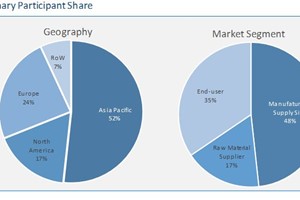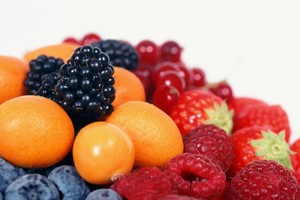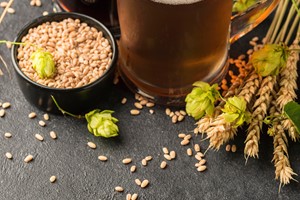Need to impart additional functional characteristics of texture, bulk, color, amongst others, to stay high in the GCC F&B industry.
It is a well-known fact that The Gulf Cooperation Council (GCC) Food & Beverage (F&B) market has been growing steadily in the last five years. Increasing influences of global trends, easy access to international brands, and growing disposable income have made the GCC F&B market a focus for most global and local brands in the Middle East region.
The steady growth of the F&B industry, despite the COVID 19 pandemic, has resulted in the HORECA boom and growth opportunities for regional and local players. However, on the flip side, global health statistics indicate that cardiovascular issues are rising and are considered one of the most prevalent health conditions in the Middle East. According to the statistics from WHO and SHA (System of Health Accounts), it had proportional mortality of up to 40% for the UAE and 37% for the KSA in 2019. Data also denotes that diabetes and obesity are also on the rise, with the 8 Middle Eastern countries (Kuwait, Qatar, Egypt, Saudi Arabia, the UAE, Bahrain, Jordan, and Lebanon) together having the highest global ratio of obesity among adults at 27% with around 40% of the total population being obese.
Customer Preferences Changing the Dynamics of F&B Industry
End consumers are actively realigning their priorities. Health and wellness govern their food choices and purchasing behavior, especially in the last two years. The change in perception is aided by governments and standardization agencies, who are actively revamping their food standards, rules, and regulations to improve the general health and well-being of the population. One of the latest is the proposed regulation of sweetener use in F&B products by the GSO (GCC Standardization Organization). Healthier food choices and well-being concept has resulted in a paradigm shift of the GCC F&B industry. F&B companies are actively integrating healthier variants in their product portfolio and trying to redesign their product formulations.
One of the key ingredients that have been of focus is the sweeteners used in F&B products. There is a wide range of sweeteners available in the market ranging from traditional sugar, honey to artificial and natural sweeteners. Alternate sweeteners or sugar substitutes as they are commonly known as are available in various formats such as granules, powders or liquids depending on the product that they are intended for use. A range of sweeteners have been developed with various levels of sweet intensity for the F&B industry. Many choices are available, and these alternative sweeteners have become commonplace for use in processed, baked and confectionery, and beverage applications.
Growing Focus on Natural Sweeteners
The health and wellness trend amongst consumers and various targeted awareness campaigns by governments and industry participants on the rising incidence of lifestyle disorders such as obesity and diabetes in the region has resulted in a shifting focus towards the use of natural sweeteners as compared to the well–established artificial sweeteners such as aspartame. Apart from the reasons mentioned above, the ability of these sweeteners to provide value-added benefits such as enhancing immunity makes it an attractive choice for use in F&B applications. A wide range of natural sweeteners are available, derived from various sources, with Stevia being one of the widely used. The sweetener has immense application, with its use in beverages being noteworthy, followed by other processed foods, confectionery, and baked goods. Well-known players such as Sweet Green Fields, PureCircle, Cragill, ADM amongst others have already commercialized their stevia-based sweeteners in the GCC region. Stevia manufacturers are active in launching a wide range of product portfolio of low-calorie, high-intensity sweeteners. They are also keen on establishing partnerships with local and global product developers to commercialize stevia-based food products.
According to data from Purecircle, interest in natural sweeteners has resulted in a 30% increase of food products developed in the year 2019-2020 compared to the year 2017. This showcases the popularity of the ingredient. Apart from stevia, other natural sweeteners derived from coconut sugar, honey, maple syrup, agave nectar, monk fruit are also quite popular for use in beverages, powdered mixes, processed and baked goods etc., in the region. The industry participants are active in R&D; deionized grapefruit concentrate and date palm sugar are the latest entrants in the natural sweeteners category that is gaining interest amongst F&B companies. R&D efforts towards the use of microbes to develop sweeteners such as brazzein, Manitol, and polyols can extend the portfolio of commercial sweeteners in the mid to long term.
The Road Ahead
Despite the perceived value-added benefits, it's evident that natural sweeteners still don't dominate the market. Apart from the comparatively higher cost, issues related to after taste and texture hinder its adoption potential. From a manufacturing standpoint, issues related to purity, yield, and quality persist despite several developments in the manufacturing and processing front, especially related to Stevia. Stakeholders are investigating the potential of multi-ingredient sweeteners that can potentially overcome some of the challenges mentioned above. R&D efforts related to the use of microbes to express sweetening agents devoid of any lingering after taste are promising; however, these are still in very early stages of research and commercial feasibility is still a long way to go.
With consumers becoming increasingly judicious in their choices of sugar alternatives, the potential for natural sweeteners is expected to increase steadily. With companies actively investing in R&D and commercialization efforts to replace sugar in all aspects, natural sweeteners need to impart additional functional characteristics such as texture, bulk, color, etc., to stay high in the GCC F&B industry.
Aarthi Janakiraman
Research Manager, TechVision, Frost & Sullivan














